Army Vietnam War Whiting, IN Flight date: 04/10/24
By Al Konieczka, Honor Flight Chicago Veteran Interview Volunteer
Thomas Legg grew up in North Hammond, Indiana. His father, a World War II veteran, was in the Civil Defense and was a very strict man. Tom was in the Boys Scouts and also took first aid courses for his medical merit badges. Tom’s father wanted him to be a first responder. Tom needed to do a lot of studying for his medical merit badges so he attended special school two days per week. One day Tom studied with the Red Cross and the other with the Civil Defense to learn as much first aid as he could. At the age of 14 Tom passed The Red Cross test and became the youngest first responder in the state of Indiana. The medical training he received at that early age would help him later in Vietnam.
Growing up Tom had many struggles with his father. So at the age of 14 Tom was sent to Texas to stay with his grandfather. Tom admitted it was probably the best thing for him. It got him away from his father and he learned so many things. His grandfather and uncle taught him how to shoot and how to hunt. Tom recalled, “My grandfather handed me a Winchester rifle on my 15th birthday and said we’ll teach you how to use this and who knows where this will take you.“
Eventually Tom and his “old man” as Tom referred to him, came to an understanding and Tom came back home to Northwest Indiana. When he returned from Texas, Tom spent a lot of time at the US 30 Dragstrip in Schererville, Indiana. Tom told me, “I was walking around the pits and watching guys working on cars and I told my old man, I know I have enough mechanical savvy within me to do this.“
Despite being very strict, Tom’s dad taught him a lot. He credits his father with giving him his mechanical background. “My old man and my uncle could tear apart an engine, put everything in a big barrel and when they were finished putting it back together, there were never any leftover parts in that barrel. I started working with them at the age of 12 rebuilding engines.“
Tom also raced go carts when he was growing up. He raced in a custom go cart at Wright’s Barnyard in Lansing, Illinois, and for the two years he raced that custom go cart, he never lost a race. That was the start of his racing career. Tom told me, “I bought a 1956 Chevy for $250 and put a modified 409 engine in it and I won my class with that car at the age of 16. My old man had to come sign for me each week I raced at the track because of my age.“
As he finished high school, Tom knew he was going to be drafted. Tom decided he would go into Engineering in the Army because he had such a strong mechanical background. The Army recruiter told Tom he could run bulldozers, cranes with all the attachments and other large pieces of equipment. At first, Tom thought that sounded good. But the recruiter told him he couldn’t do that job if he was drafted, he had to enlist. Tom told me in a loud tone, “I didn’t want to enlist. I wanted no part of this war. I was making good money with my racing. I wanted no part of Vietnam or the Army. I told my old man, if they sent this to me, what am I gonna do? My dad told me, if you get drafted, you’re gonna go!“
Tom’s birthday was August 30 and it was the day of the draft lottery just as he turned 18. His number was three in the draft so he knew he was headed to Vietnam. “I ended up going for my basic training at Fort Polk, Louisiana and they said, why did you end up down here? We don’t want your Yankee ass down here – and that’s how I ended up getting my nickname. The nickname started out as Yankee and then became 54-Yankee when I was on search and rescue.“
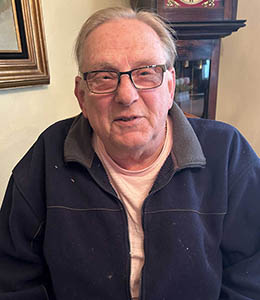
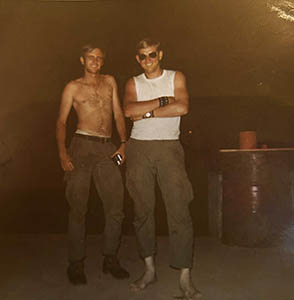
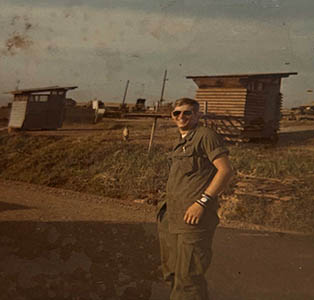
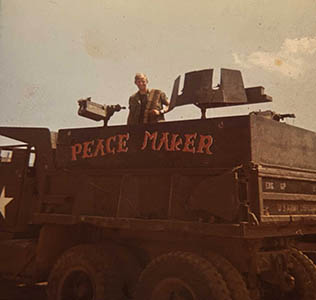
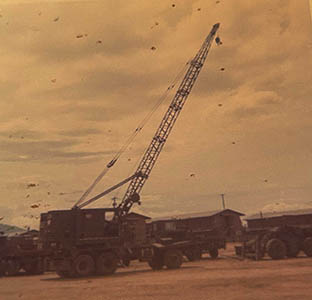
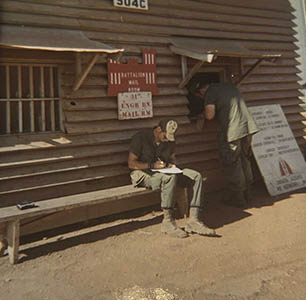
Tom did very well in basic training and was an excellent marksman. Tom prided himself on the training and skills he had learned from his grandfather while in Texas. “At the end of my AIT they came and told me we want you to go down to Fort Benning, Georgia. They had a rifle competition down there called Army’s Top Shot. They told me you’re gonna compete against some of the best shooters the Army has. Three days in a row, I scored 100. There were three of us at the top of the list and the other two guys ran the sniper school. I ended up beating these guys and became the Army’s top shot.“
After Tom won that competition, he was visited by a man who brought him a custom made 50 caliber sniper rifle built in Belgium. Tom recalled, “The gentleman who brought me the gun said, I’ve only built two of these in my lifetime, this is the third and I want you to have it. He said, you’re going to Fort Bragg tomorrow to meet the 160th Soar. You just might end up working with these guys.” The 160th Special Operations Aviation Regiment’s (SOAR), also known as Night Stalkers, were a group of Soldiers recognized for their proficiency in nighttime operations. Tom didn’t end up working with the SOAR but he once again learned some valuable things.
Soon Tom was off to Vietnam. He flew out of Fort Lewis near Tacoma, Washington and arrived in Vietnam on November 1, 1971. He first landed in Da Nang and then headed up to Phu Bai in a helicopter the next day. They were 60 miles from the DMZ in the A Shau Valley along the border of Laos on patrols in the jungle. Tom said, “We would be out for up to 20 days and live off the choppers coming to feed and supply us. We would pair up and hook our ponchos together and tie them with boot laces, prop them up with little sticks and dig a small trench and that’s where we stayed for two or three days before moving on.”
At one point, Tom’s Colonel approached him and told him he fit all the criteria to do the job of search and rescue if he wanted it because they didn’t have enough Parachute Jumpers (PJs). Tom remembered, “I thought, you know what, if that was me laying out there, I’d want someone to come and get me so I told him, I’ll do it.” Tom spent about a month and a half on search and rescue missions and brought back about 35 soldiers until they finally had enough PJs on hand to take his place.
Within an hour of that initial decision Tom was on a helicopter headed to the Coral Sea. Tom recalled, “That first day, I was sent out to rescue men down on the ground. The scariest thing is going down on that cable through the tree tops because you have no idea what’s waiting down below. Now my medical training from when I was younger really helped me with this job. We had a medic on the chopper but on the ground, I had to treat the soldiers before getting them up to the chopper on the cable. If I got stuck down there, I had to do everything myself to treat these guys – and that happened several times.“
Tom recalled three times where the chopper he was flying in got shot down and had to crash land with no power. “The pilot would stick that chopper in the trees and we would set charges and drop to the ground and run before the chopper blew up. Then we wait for the Sandies to arrive.” Rescue helicopters were too vulnerable to operate alone. The preferred escort was a flight of A-1 Sandys. Their guns, bombs, and rockets kept enemy ground forces at bay until rescue choppers arrived.
During his time performing search and rescue missions, Tom became very good friends with Mr. Lee who was a Korean helicopter pilot. Tom recalled, “That guy could drink until 4am and be up at 5am to fly that chopper. He was an awesome pilot. He asked me one night, do you want to fly with me into the beehive tomorrow? I didn’t know what that was so I agreed. We loaded all the bullets in there to feed into the machine guns and we dropped all the grenades into a barrel. So the job was to give air support to guys down on the ground waiting to be rescued. As we neared the area, Mr. Lee said, you ready, there’s the purple smoke. We need to shoot to the right of it. So as we shot from our plane, shots were coming up and bouncing off our helicopter. We had enough ammo to make two passes. On the way back to camp Mr. Lee said, You know, you’re the only guy who’s ever come up here to do this with me. I don’t know what to say. That’s what they call flying into the beehive.“
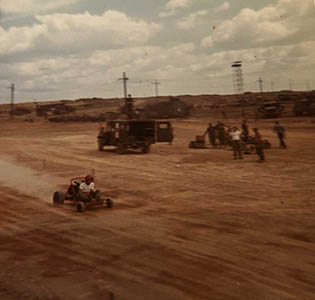
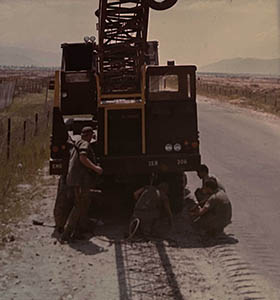
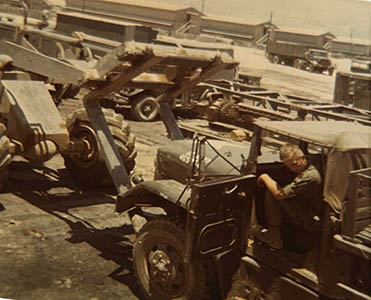
On Tom’s last search and rescue mission he went down the cable and as he hit the tree line, he heard gunfire. “I hear this pop, pop, pop. Then I heard the bullets hitting the chopper. I heard through my headset they were going to abort and I was detached and dropped to the ground. I saw three guys shooting at the chopper so I killed them. I told the chopper I killed the enemy so come back for us. The Navy guys I went down to rescue were in white uniforms so gave them all clothes to put on to get rid of their whites. One of them was a Commodore, one step below a rear Admiral. He had a compound fracture in his leg which I had to set. I had to help the Commodore out as we walked to the extraction area miles away.“
Then next morning, they were picked up and flown out to the Coral Sea. The Commodore was very grateful to Tom for saving his life. In the afternoon, Tom was in his bunk and the Commodore came to see him and said, “Tomorrow morning you’re with me. I’ve got a special assignment for you.” Tom flew with the Commodore to his compound and met with Tom’s CO and Tom was reassigned to the Commodore’s command. He took Tom to a gated community about 3 acres in size and said, this is your assignment now. You work here safe until your tour is up. You saved my life, now I’m paying you back.
Tom found himself relocated from the A Shau Valley to the Ia Drang Valley. Tom compared the two places. “The A Shau Valley was a nightmare of a war zone. They kept sending guys into the fight and we kept sending them home in body bags. That was the part I hated the most. I just wondered when would it be my time to be in one of those bags. When I got to the Ia Drang Valley, it was like a holiday compared to where I had just come from.“
Tom continued to run patrols two days a week to the river and convoys out of his camp three days a week up to Phu Bai to deliver ammunition to keep the effort in Khe Sanh going. Tom had 10 truck drivers that drove with him each week and he wasn’t about to leave those men on their own while he sat around. The Commodore told Tom to do whatever he needed to keep things going, but at the end of the day he should come back there.
Near the end of his tour, Tom went back to Da Nang and was attached to the 507th light engineer company and he stayed with that unit until he went home. One week they built a go cart track and Tom built a go cart that won every race – no surprise given his previous racing experience.
During his initial training, Tom also took an explosive ordinance class where he learned to make satchel charges. A satchel charge is a demolition device, primarily intended for combat, whose primary components are a charge of dynamite or a more potent explosive such as C-4 plastic explosive, a carrying device functionally similar to a satchel and a triggering mechanism. Over the course of several days, Tom and his squad blew up two NVA stronghold buildings.
In Vietnam, along the rivers, Tom and his men often encountered Red Chinese troops. One night Tom made 70 barrels of fougasse as a last line of defense at the fire base perimeter. Fougasse is a type of mine or improvised explosive device which uses an explosive charge to project burning liquid onto a target. Tom recalled, “I told my captain, if they come at us tonight, I’m gonna give you a show you ain’t never seen before. The barrels had a claymore mine at the bottom along with shredded fiberglass, bags of white phosphorus (WP), napalm and gasoline all in a 55 gallon drum set in the ground at an angle triggered with a command detonator. The next time the Red Chinese troops came through the elephant grass we set off these barrels. All you see is fire through the air and it was huge. Just three barrels of this stuff going off is like the size of a semi-truck flying through the air and it lands on them. And you can’t put this out. It will burn under water. I learned how to make that up there in the A Shau Valley.“
Tom was in country a total of 10 months. He left Vietnam on August 25, 1972 just a few days before his 21st birthday. He really wanted to see his mom and family and his buddies and get back to the drag strip. However, Tom was very upset with the way soldiers were treated when returning home. “When we came home to the world, we were public enemy number one. It was terrible. Fifteen minutes off the airplane I’ve got college kids running at me swinging and spitting and everything else. Two of them came at me and I dropped them. I gave them both throat chops and they never moved.”
Tom first met his wife Nancy a few nights after he came home from Vietnam at his parent’s house. She was a friend of his brother’s girlfriend. His first date with Nancy was at the 41 Outdoor Theater. Tom and Nancy will be married for 49 years as of May 24th. Tom shared with me, “I owe Nancy my life. My wife helped me through all my PTSD issues. I put her through hell. She has seen me many times wake up with nightmares.”
When Tom returned from the war, he began working at Youngstown Steel as a crane operator. He later took the entrance exam for Boilermaker at Inland Steel. He passed and became one of a very few Boilermaker welders at Inland. He worked there at Inland for 31 years before retiring.
Tom and Nancy have two sons and a daughter and one grandson who Tom loves so much. His grandson is a spitting image of Tom when he was young with blonde hair and blue eyes. Tom enjoys building model cars and fishing and used to detail cars after he retired.
Tom was awarded the Army Commendation Medal and the Vietnam Service and Vietnam Campaign Medals.
Tom, thank you very much for your dedicated service. Enjoy your well-deserved trip to Washington D.C.!


